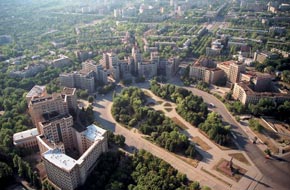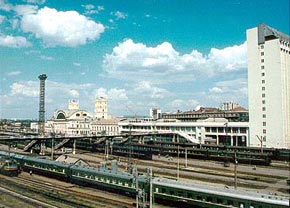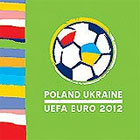Kharkov is the second largest city in Ukraine. It is the administrative center of the Kharkiv Oblast (province), as well as the administrative center of the surrounding Kharkivskyi Raion (district) within the oblast. The city is located in the northeast of the country. As of 2006, its population is 1,461,300. People living in Kharkiv are known as Kharkovites.
Kharkiv is one of the main industrial, cultural and educational centres of Ukraine. Its industry and research specialize on arms production and machinery. There are hundreds of industrial companies in the city. Among them are world famous giants Morozov Design Bureau and Malyshev Tank Factory (Zavod Malysheva, a leader in tank production since the 1930s), Hartron (aerospace and nuclear electronics) and Turboatom (turbines producer).
There is an underground rapid-transit system with 35 km of track and 28 stations. Another landmark of Kharkiv is its Freedom Square (Ploshcha Svobody), which is the second largest city square in Europe, and the 4th largest square in the world. |
Freedom square, the fifth largest square in the world. |
Kharkov on video 40 MB live
Download here
 |
Railways
The first railway connection of Kharkiv was opened in 1869. The first train to arrive in Kharkiv came from the north on May 22nd, 1869, and on June 6th, 1869, traffic was opened on the Kursk-Kharkiv-Azov line. Kharkiv's passenger railway station was reconstructed and expanded in 1901, to be later destroyed in the Second World War. A new railway station was built in 1952.
Various railway transportation methods available in the city are the: Railway trains, and elektrichkas (regional electric trains).

|
Geography of Kharkov
Kharkiv rests at the confluence of the Kharkiv, Lopan, and Udy Rivers, where they flow into the Seversky Donets watershed.
History of Kharkov
Archeological evidence discovered in the area of present-day Kharkiv indicates that a local population has existed in that area since the 2nd millennium b.c.e. Cultural artifacts date back to the Bronze Age, as well as those of later Scythian and Sarmatian settlers. There is also evidence that the Chernyakhov culture flourished in the area from the 2nd to the 6th century.
Founded in the middle of 17th century, the city has had a university since 1805. During the early years of the Soviet Union, Kharkiv was the capital of the Ukrainian Soviet Socialist Republic (from 1917?1934). In the early 1930s, the Ukrainian famine (Holodomor) drove many people off the land into the cities, to Kharkiv in particular, in search of food. Some of them died and were secretly buried in one of the city's cemeteries. During April and May 1940 about 3800 Polish prisoners of Starobelsk camp were killed in the Kharkiv NKVD building, later buried in Pyatikhatky forest (part of the Katyn massacre).
During World War II Kharkiv was the site of several military engagements. The city was captured by Nazi Germany and its military allies, recaptured by the Red Army, captured again twice by the Nazis and then finally liberated on August 23, 1943. Seventy percent of the city was destroyed and tens of thousands of the inhabitants were killed. It is mentioned that Kharkiv was the most populated city in the Soviet Union occupied by Nazis, since in the years preceding World War II Kiev was the smaller of the two by population. Between December of 1941 thru January of 1942, an estimated 30,000 people were killed by the nazis (mostly Jewish). They were laid to rest in one of the largest mass graves that is known as Drubitsky Yar.
|
«International Airport Kharkov»
Kharkov airport is registered in International organization ICAO, and operates the air traffic control and navigation newest systems. The airport has runway with length of 2200 metres that allows servicing of take-off-landing for many types of aircrafts. The airport has all necessary offices for servicing the international flights.

Kharkov National University
|
First Battle of Kharkov
As part of Operation Barbarossa, the German Army South Group advanced toward the city of Kharkov in the Soviet Union (now Kharkiv, Ukraine) on October 20, 1941. The Russian 38th Army set up a defense at the city. Meanwhile, entire factories were dismantled for relocation farther east. By October 21, all of the factory equipment had been loaded on to rail trains. On this day the Germans closed to within seven miles of the railyards. The German 6th and 17th Armies attacked Russian positions on October 24 and took control of the city on the same day.
Second Battle of Kharkov
The Second Battle of Kharkov was a battle fought from 12 May to 28 May 1942, on the Eastern Front during World War II. After a successful winter counteroffensive that repulsed German troops from Moscow but also depleted the Red Army's reserves, the Kharkov offensive was a new Soviet attempt to expand upon their strategic initiative.
Third Battle of Kharkov
The Third Battle of Kharkov was the last major strategic German victory of World War II. Kharkov had originally been captured on October 25, 1941, but had fallen to the Soviets in February 1943, following the German defeat at the Battle of Stalingrad. Led by Field Marshal Erich von Manstein, the Germans counter-attacked and after destroying Soviet spearheads, retook the city in bitter street fighting.
Fourth Battle of Kharkov
Operation Polkovodets Rumyantsev (literally: "Commander Rumyantsev", after 18th-century Field Marshal Peter Rumyantsev) was a military operation conducted by the Red Army in its fight against the German Wehrmacht during World War II. The operation was conducted by Steppe Front in the Belgorod sector.
|
Sport
Kharkiv is one of Ukraine's largest cities and as in the whole country sports are taken seriously. The most popular sport is football. City has two clubs playing in the Ukrainian Premier League.

Poland and Ukraine to host EURO 2012
Michel Platini, the UEFA President, announced the decision of the Executive Committee. Poland and Ukraine have been chosen to host EURO in 2012.
Szewczenko and Dudek in a single team
Andrij Szewczenko and Jerzy Dudek were among those arguing in favour of the Poland-Ukraine bid during the final presentation in Cardiff. During announcement of the presentation by those two stars of world football, a film was screened showing the famous defence by Dudek of the penalty by Szewczenko during a match between Liverpool and AC Milan.

Metalist medallists set for Europe
by Igor Linnykfrom Kiev
FC Metalist Kharkiv are preparing for a first European campaign in 19 years after a win on Saturday guaranteed them the bronze-medal slot in Ukraine.
|

|
Attractions
Of the many attractions of the Kharkiv city are the: Gosprom building, Memorial Complex, Freedom Square, Taras Shevchenko Monument, Mirror Stream, Uspensky Cathedral, Militia Museum, Pokriv Cathedral, T. Shevchenko Gardens, Kharkiv's funicular (shut down due to accident), Blagovishensky (Blessed News) Cathedral, Children's narrow-gauge railroad, Building on Sumskaya Street #6,and many more.
|


